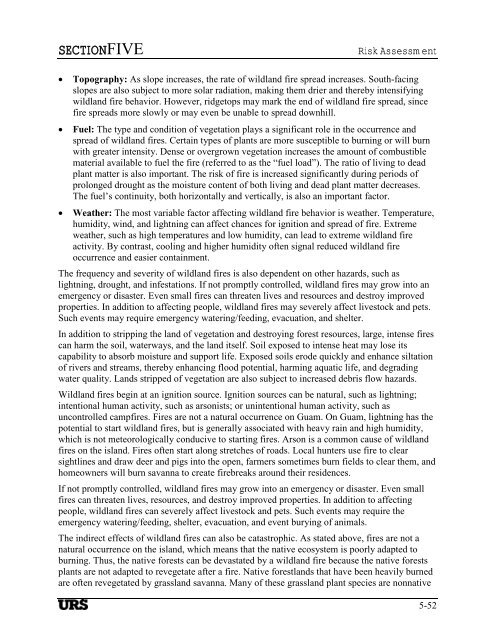Guam Hazard Mitigation Plan - Western States Seismic Policy Council
Guam Hazard Mitigation Plan - Western States Seismic Policy Council
Guam Hazard Mitigation Plan - Western States Seismic Policy Council
Create successful ePaper yourself
Turn your PDF publications into a flip-book with our unique Google optimized e-Paper software.
SECTIONFIVERisk Assessment• Topography: As slope increases, the rate of wildland fire spread increases. South-facingslopes are also subject to more solar radiation, making them drier and thereby intensifyingwildland fire behavior. However, ridgetops may mark the end of wildland fire spread, sincefire spreads more slowly or may even be unable to spread downhill.• Fuel: The type and condition of vegetation plays a significant role in the occurrence andspread of wildland fires. Certain types of plants are more susceptible to burning or will burnwith greater intensity. Dense or overgrown vegetation increases the amount of combustiblematerial available to fuel the fire (referred to as the “fuel load”). The ratio of living to deadplant matter is also important. The risk of fire is increased significantly during periods ofprolonged drought as the moisture content of both living and dead plant matter decreases.The fuel’s continuity, both horizontally and vertically, is also an important factor.• Weather: The most variable factor affecting wildland fire behavior is weather. Temperature,humidity, wind, and lightning can affect chances for ignition and spread of fire. Extremeweather, such as high temperatures and low humidity, can lead to extreme wildland fireactivity. By contrast, cooling and higher humidity often signal reduced wildland fireoccurrence and easier containment.The frequency and severity of wildland fires is also dependent on other hazards, such aslightning, drought, and infestations. If not promptly controlled, wildland fires may grow into anemergency or disaster. Even small fires can threaten lives and resources and destroy improvedproperties. In addition to affecting people, wildland fires may severely affect livestock and pets.Such events may require emergency watering/feeding, evacuation, and shelter.In addition to stripping the land of vegetation and destroying forest resources, large, intense firescan harm the soil, waterways, and the land itself. Soil exposed to intense heat may lose itscapability to absorb moisture and support life. Exposed soils erode quickly and enhance siltationof rivers and streams, thereby enhancing flood potential, harming aquatic life, and degradingwater quality. Lands stripped of vegetation are also subject to increased debris flow hazards.Wildland fires begin at an ignition source. Ignition sources can be natural, such as lightning;intentional human activity, such as arsonists; or unintentional human activity, such asuncontrolled campfires. Fires are not a natural occurrence on <strong>Guam</strong>. On <strong>Guam</strong>, lightning has thepotential to start wildland fires, but is generally associated with heavy rain and high humidity,which is not meteorologically conducive to starting fires. Arson is a common cause of wildlandfires on the island. Fires often start along stretches of roads. Local hunters use fire to clearsightlines and draw deer and pigs into the open, farmers sometimes burn fields to clear them, andhomeowners will burn savanna to create firebreaks around their residences.If not promptly controlled, wildland fires may grow into an emergency or disaster. Even smallfires can threaten lives, resources, and destroy improved properties. In addition to affectingpeople, wildland fires can severely affect livestock and pets. Such events may require theemergency watering/feeding, shelter, evacuation, and event burying of animals.The indirect effects of wildland fires can also be catastrophic. As stated above, fires are not anatural occurrence on the island, which means that the native ecosystem is poorly adapted toburning. Thus, the native forests can be devastated by a wildland fire because the native forestsplants are not adapted to revegetate after a fire. Native forestlands that have been heavily burnedare often revegetated by grassland savanna. Many of these grassland plant species are nonnative5-52




